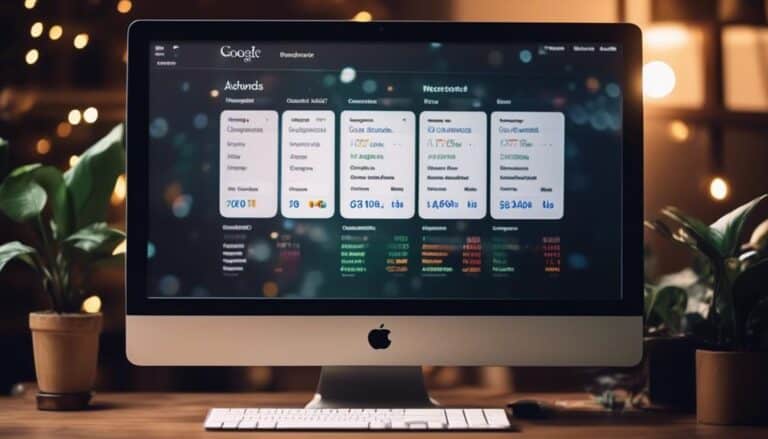Beyond Bidding: Advanced Strategies for Cost-Effective PPC Campaigns
Are you aware that over 45% of clicks on Google's search results page go to the top three paid ads?
While bidding plays a crucial role in PPC campaigns, there exist advanced strategies beyond mere bidding that can significantly impact the cost-effectiveness of your campaigns.
By exploring enhanced keyword targeting, ad copy optimization techniques, and utilizing ad extensions effectively, you can unlock a realm of possibilities to elevate your PPC game.
But there's more to uncover beyond these basics that could revolutionize your approach to online advertising.
Key Takeaways
- Utilize long tail keywords for higher conversion rates
- Implement remarketing strategies to enhance conversions
- Regularly analyze search terms for new opportunities
- Optimize ad copy with creative messaging and unique selling propositions
Enhanced Keyword Targeting

How can you optimize your PPC campaigns through enhanced keyword targeting to increase click-through rates and conversions?
By leveraging long tail keywords and conducting thorough competitive analysis, you can refine your targeting strategy to reach a more qualified audience. Long tail keywords, consisting of longer and more specific phrases, can help you attract users who are closer to the point of conversion. Through competitive analysis, you can identify gaps in the market and capitalize on keywords that your competitors may be overlooking.
Another crucial aspect of enhanced keyword targeting is the incorporation of negative keywords and regular search term analysis. Negative keywords help you exclude irrelevant traffic, ensuring that your ads are shown to users who are more likely to engage with your content. By continuously analyzing search terms, you can uncover new keyword opportunities and refine your targeting based on real-time data.
Ad Copy Optimization Techniques
To further enhance the performance of your PPC campaigns beyond keyword targeting, implementing strategic ad copy optimization techniques is paramount for maximizing click-through rates and conversions. Creative messaging plays a crucial role in capturing the attention of your target audience. Crafting compelling ad copy that resonates with your potential customers can significantly impact the success of your campaigns. By incorporating unique selling propositions, calls to action, and engaging language, you can differentiate your ads from competitors and drive higher engagement levels.
In addition to creative messaging, split testing is a powerful technique to optimize your ad copy effectively. By testing different variations of your ads, you can gather valuable data on what resonates best with your audience. Analyzing the performance of these variations allows you to refine your messaging continuously and improve the overall effectiveness of your PPC campaigns.
Utilizing Ad Extensions Effectively

Implementing ad extensions strategically enhances the visibility and relevance of your PPC ads, contributing to higher click-through rates and improved ad performance. When utilizing ad extensions effectively, consider the following:
- Sitelink Extensions: Direct users to specific pages on your website, increasing the chances of conversions. Track the performance of each sitelink to optimize for better results.
- Callout Extensions: Highlight key benefits or unique selling points of your products/services. These concise snippets provide additional information to users, increasing ad relevance and click-through rates.
- Structured Snippet Extensions: Showcase different aspects of your offerings such as product categories, services, or brands. By measuring ROI on each structured snippet, you can refine your ad content to resonate better with your target audience.
Harnessing the Power of Remarketing
Maximizing your PPC campaign's potential involves strategically leveraging the capabilities of remarketing to engage with your audience effectively and drive conversions. Remarketing, also known as behavioral retargeting, allows you to reconnect with users who've previously visited your website but didn't convert. By targeting these individuals with tailored ads as they browse other websites or social media platforms, you can increase brand awareness and encourage them to return and complete a desired action.
To optimize conversions through remarketing, it's crucial to segment your audience based on their behavior on your site. By creating specific audience lists, you can deliver personalized ads that speak directly to their interests and needs. Additionally, consider adjusting your bidding strategy for remarketing campaigns to prioritize users who've shown a higher intent to convert.
Furthermore, continuously analyze the performance of your remarketing campaigns, testing different ad creatives, messaging, and audience segments to identify what drives the best results. By refining your approach based on data-driven insights, you can enhance conversion rates and maximize the impact of your PPC efforts.
Leveraging Audience Segmentation

By segmenting your audience effectively based on their behavior on your site, you can tailor your remarketing campaigns to deliver personalized ads that resonate with their interests and needs.
Customized audience segmentation and behavioral targeting allow you to create specific audience groups based on their interactions with your website, enabling you to craft highly personalized ads that are more likely to convert.
Additionally, leveraging demographic targeting helps you reach audiences based on factors like age, gender, income, and interests, ensuring your ads are seen by those most likely to engage with them.
Geographic segmentation further refines your targeting by focusing on specific locations where your target audience is located, maximizing the relevance of your ads and increasing the chances of driving conversions.
Implementing A/B Testing Strategies
To optimize your PPC campaigns, start by testing different ad copies to see which resonates best with your audience.
Experiment with various targeting options to reach the right people at the right time.
Analyze the performance data meticulously to identify trends and make informed decisions for ongoing improvement.
Test Ad Copy
Implementing A/B testing strategies for ad copy is crucial for optimizing your PPC campaign's performance and achieving higher conversion rates.
When testing ad copy, remember to:
- Focus on One Element: Test variables like headlines, descriptions, or calls-to-action individually to understand their impact better.
- Utilize Data Insights: Analyze metrics such as click-through rates and conversion rates to identify the most effective ad copies.
- Iterate and Refine: Continuously refine your ad copy based on A/B test results, incorporating successful elements into future iterations.
Experiment With Targeting
When refining your ad copy through A/B testing strategies, the next step is to experiment with targeting to enhance your PPC campaign's effectiveness.
Behavioral targeting experimentation allows you to tailor your ads based on users' browsing habits, interests, and online behaviors. By segmenting your audience and delivering more personalized ads, you can increase click-through rates and conversions.
Additionally, geo-targeting refinement enables you to reach potential customers in specific locations, making your campaigns more relevant and impactful. Test different regions to see where your ads perform best and allocate your budget accordingly.
Analyze Performance Data
For a comprehensive evaluation of your PPC campaign's effectiveness, analyzing performance data is crucial in fine-tuning your strategies for optimal results. Here's how you can leverage data to enhance your campaigns:
- Conversion Rate Analysis: Compare conversion rates between different ad variations to identify which elements drive more conversions.
- Click-Through Rate Comparison: Analyze the click-through rates of your ads to understand which messages resonate best with your audience.
- Cost Per Acquisition Evaluation: Evaluate the cost-effectiveness of your campaigns by examining the cost per acquisition metrics.
Maximizing Quality Score Improvements
To achieve optimal results in your PPC campaigns, focus on maximizing the enhancements to your Quality Score. Quality score optimization is a crucial element in improving campaign efficiency and achieving cost-effective strategies. By enhancing your Quality Score, you not only lower your cost per click but also improve your ad position and overall performance.
One effective way to maximize Quality Score improvements is by optimizing your keyword relevance. Ensure that your keywords align closely with your ad copy and landing page content to increase relevance and boost your Quality Score. Additionally, improving your ad's click-through rate (CTR) by creating compelling ad copy and utilizing ad extensions can positively impact your Quality Score.
Furthermore, focusing on landing page experience is essential for Quality Score enhancement. Make sure your landing pages are user-friendly, relevant to the ad, and provide valuable content to visitors. By continuously monitoring and refining these aspects, you can drive significant performance improvement in your PPC campaigns.
Dynamic Ad Customization Methods

To enhance your PPC campaigns, consider leveraging ad copy personalization, dynamic keyword insertion, and automated ad variation. These dynamic ad customization methods enable you to tailor your messaging to specific audiences, improve relevance, and increase click-through rates.
Ad Copy Personalization
Implementing dynamic ad customization methods in your PPC campaigns can significantly boost engagement and conversion rates. By tailoring ad copy to resonate with specific customer personas and leveraging emotional triggers, you can create a more personalized and compelling experience for your target audience.
Here are three innovative ways to implement ad copy personalization effectively:
- Dynamic Keyword Insertion: Inserting the user's search query into the ad copy dynamically can increase relevance and click-through rates.
- Location-Based Personalization: Customizing ad copy based on the user's location can enhance relevance and drive local engagement.
- Product Recommendation Integration: Showcasing personalized product recommendations based on user behavior can enhance user experience and drive conversions.
Dynamic Keyword Insertion
By incorporating dynamic keyword insertion into your ad copy personalization strategy, you can directly align the user's search queries with your advertisements, increasing relevance and driving higher click-through rates. Keyword relevance optimization plays a crucial role in this strategy, allowing you to tailor your ad content to match the specific search terms users input.
Through ad group segmentation, keyword insertion customization becomes more targeted and effective. This method enables you to create more personalized and relevant ad experiences for your audience, ultimately leading to improved ad performance.
Automated Ad Variation
Enhancing your PPC campaign's effectiveness through automated ad variation requires a strategic approach that leverages dynamic ad customization methods. When implementing dynamic ad creation, you can reap several ad automation benefits:
- Personalization: Tailoring ad content to match user intent and preferences.
- Optimization: Automatically testing different ad variations to identify the most effective ones.
- Efficiency: Saving time and effort by letting algorithms manage ad customization tasks.
Embracing Mobile-First PPC Approaches

To effectively reach your target audience in today's digital landscape, prioritizing mobile-first PPC approaches is imperative. With the majority of internet users accessing content through mobile devices, optimizing your PPC campaigns for mobile is no longer optional—it's a necessity. Mobile optimization entails more than just responsive design; it involves tailoring your ad creatives, landing pages, and overall user experience to suit the preferences and behaviors of mobile users.
Consider the following table to understand the significance of mobile-first PPC strategies:
| Benefit | Description |
|---|---|
| Enhanced Visibility | Mobile-optimized ads are more likely to be seen by users, increasing the chances of engagement and clicks. |
| Improved User Experience | Responsive design ensures that your ads and landing pages display correctly on various mobile devices. |
| Higher Conversion Rates | A seamless mobile experience can lead to higher conversion rates as users find it easier to take action. |
Integrating Data-Driven Decision Making
Implementing data-driven decision making into your PPC campaigns is crucial for maximizing performance and achieving targeted outcomes. By leveraging data-driven optimization techniques, you can enhance the cost-effective analysis of your campaigns. Here are three key strategies to integrate data-driven decision making effectively:
- Utilize Advanced Analytics Tools: Implement cutting-edge analytics tools to gather and analyze data more efficiently. These tools can provide insights into customer behavior, trends, and performance metrics, allowing you to make informed decisions based on real-time data.
- A/B Testing for Continuous Improvement: Conduct A/B tests regularly to compare different ad creatives, landing pages, or targeting strategies. By testing variations and analyzing performance metrics, you can refine your campaigns for optimal results and cost-effectiveness.
- Dynamic Bid Adjustments: Employ automated bidding strategies that adjust bids based on real-time data such as device, location, or time of day. This dynamic approach ensures your bids are optimized for maximum ROI, saving costs while improving campaign performance.
Frequently Asked Questions
How Can I Effectively Balance Budget Allocation Across Different Keyword Targeting Strategies?
To effectively balance budget allocation across different keyword targeting strategies, analyze keyword performance data regularly. Adjust budget management based on high-performing keywords. Implement a flexible approach to optimize spending and maximize results. Stay innovative and data-driven to achieve cost-effective PPC campaigns.
What Are Some Creative Ways to Optimize Ad Copy for Maximum Engagement and Conversions?
To optimize ad copy for maximum engagement and conversions, try various copywriting techniques and A/B testing. Incorporate visual elements for emotional appeal. Experiment with different styles to resonate with your audience and drive results effectively.
How Can I Measure the Effectiveness of Various Ad Extensions in Driving Conversions?
To measure ad extension effectiveness in driving conversions, utilize ad performance data and conversion tracking metrics. Analyze which extensions lead to higher click-through rates and conversions. Experiment with different extensions to find the most impactful ones for your campaigns.
What Are Some Best Practices for Setting up and Managing Remarketing Campaigns?
To maximize your remarketing campaigns, implement dynamic retargeting for personalized messaging. Utilize cross-device tracking and conversion attribution for a comprehensive view. Tailor ads based on user behavior and interests to drive higher engagement and conversions.
How Can I Use Audience Segmentation to Tailor My PPC Campaigns for Different Customer Segments Effectively?
To tailor your PPC campaigns effectively for different customer segments, utilize audience segmentation. By creating customer personas and leveraging targeting options, you can customize ads for personalization. This strategic approach enhances relevance and improves campaign performance.
Conclusion
In conclusion, incorporating advanced strategies in your PPC campaigns can significantly improve cost-effectiveness and overall performance.
By enhancing keyword targeting, optimizing ad copy, utilizing ad extensions, harnessing remarketing, segmenting audiences, improving quality scores, customizing ads dynamically, adopting mobile-first approaches, and making data-driven decisions, you can maximize your campaign's impact and ROI.
Stay ahead of the competition by implementing these advanced tactics and continuously monitoring and adjusting your campaigns for optimal results.








